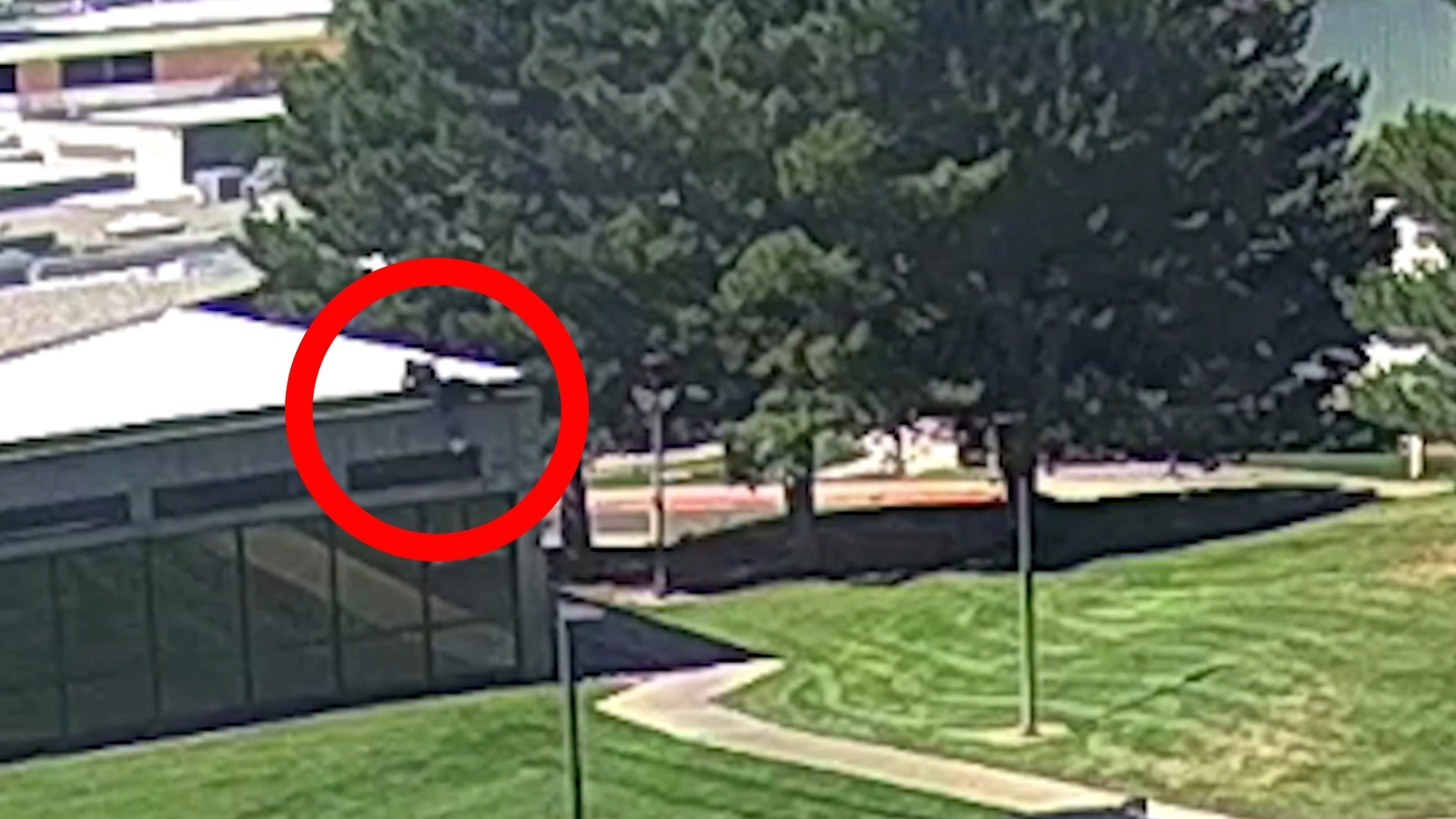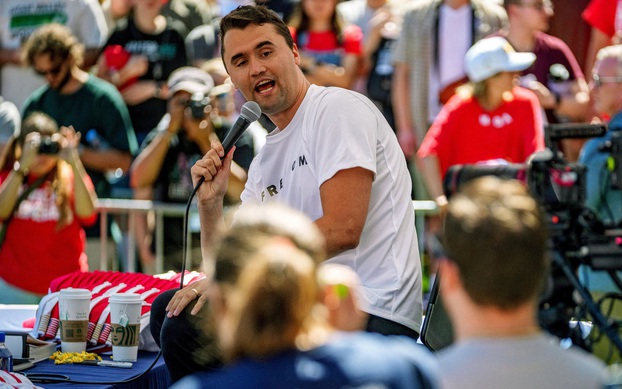Caught Red-Handed! Tyler Robinson’s “Perfect” Alibi Shattered by 6:38 PM Photo — Investigators Say This Changes Everything!
When a photo taken at exactly 6:38 PM first surfaced, it appeared harmless. It looked like one of those casual snapshots people take without a second thought — mundane, ordinary, unremarkable. Yet as investigators and independent analysts began examining it more closely, the image transformed from an overlooked piece of digital clutter into the
The photo didn’t just raise questions — it challenged the entire narrative that Tyler Robinson had carefully constructed. His alibi, which he once described as “airtight,” suddenly became porous. Every detail he had confidently shared with investigators was now under scrutiny because the timestamped image said something different.
According to image analysis experts, a single detail inside that frame — one that almost everyone initially ignored — carried enough weight to upend weeks of assumptions. Once magnified and enhanced, it exposed a contradiction so significant that investigators were forced to reevaluate their earlier conclusions. One investigator even admitted:
“We overlooked this for too long. We shouldn’t have.”
What had been a straightforward timeline became a puzzle with missing pieces. And the 6:38 PM photo, once dismissed, became the missing key.

A Timeline Built on Certainty — Or So It Seemed
Before the 6:38 PM photo emerged, the sequence of events appeared simple. Tyler Robinson had presented a clear, rehearsed, and confident account of where he was, who he was with, and what he was doing during a critical window of time. His statements aligned with what little digital evidence existed. Nothing seemed amiss.
Investigators found Tyler cooperative, calm, and articulate. He had answers ready for every question. His alibi involved:
-
a specific location
-
a short list of people
-
a consistent sequence of events
-
and a timeframe that seemed verifiable
For a while, no one suspected any inconsistencies. Everything seemed to match.
But the timeline had one weakness: it depended entirely on the absence of contradictory evidence.
The photo changed everything.
The Photo Emerges — Quietly, Almost Accidentally
The 6:38 PM photo wasn’t discovered through a dramatic revelation. It didn’t come from a whistleblower, nor did it appear through a major data leak. Instead, it surfaced quietly when an analyst was reviewing unrelated files from a device belonging to someone only loosely connected to the case.
Initially, the image was nearly dismissed. It showed:
-
an outdoor background
-
dim evening lighting
-
a figure in the distance
-
and a few everyday objects
Nothing about it seemed unusual.
But then someone noticed the timestamp.
6:38 PM.
A time Tyler insisted he was somewhere else entirely.

That alone wouldn’t have been enough to raise suspicion — timestamps can be wrong, devices can glitch — but curiosity led investigators to look closer.
What they found was not a glitch.
It was a contradiction.
If Not a Glitch, Then What?
Experts were brought in to verify the authenticity of the timestamp.
The findings were clear:
-
The device’s internal clock had not drifted.
-
No manual adjustments had been made.
-
GPS metadata matched the timestamp.
-
The file had not been edited or altered.
Everything about the photo was genuine.
With the timestamp verified, investigators turned their attention to what was actually in the image. At first glance, it was nothing more than a grainy scene in low evening light. But zooming in revealed something subtle — so subtle that most people would never have noticed it.
A reflection.
A shape.
A shadow.
Something that wasn’t supposed to be there if Tyler’s account were accurate.
This tiny detail is what experts later described as “the keystone that shifted the entire structure.”
The Detail No One Saw — Until They Did
When specialists enhanced the photo, one object caught their attention: a distinctive article that appeared to match something Tyler was known to have at the time.
It wasn’t incriminating.
It wasn’t dramatic.
It was simply… out of place.
But being out of place at 6:38 PM meant being somewhere Tyler claimed he wasn’t.
This contradiction forced analysts to reconstruct the entire evening, step by step.
If the object in the photo was what they believed it to be, it meant:
-
Tyler’s timeline was inaccurate
-
His whereabouts were different than he stated
-
And his “airtight” alibi was suddenly full of gaps
This was enough to prompt a deeper reexamination of his entire statement.
Investigators Rebuild the Timeline From Scratch
The emergence of the 6:38 PM photo forced investigators to abandon earlier assumptions. Instead of starting with Tyler’s version and checking for contradictions, they reversed their method:
Start with the photo. Work outward. Fill the timeline around it.

They reconstructed:
-
location data
-
estimated travel times
-
digital footprints
-
environmental lighting conditions
-
nearby camera angles
-
and witness recollections
The adjustments were dramatic.
What had once been a smooth timeline became a jagged sequence of inconsistencies. The window between 6:20 PM and 6:45 PM, which previously seemed negligible, now became the most crucial period of the evening.
The 6:38 PM photo sat right in the middle — an immovable anchor.
Data Specialists Step In
A team of civilian data analysts was brought in to review the photo independently. Their findings were remarkably consistent with those of the investigators:
-
The object in the image matched known items
-
The lighting conditions corresponded precisely with the timestamp
-
The background landmarks confirmed the location
-
Several frame elements aligned with verified environmental data
Most importantly, experts determined that the person visible in the distance was consistent in height and build with Tyler Robinson — though not conclusively identifiable.
But the data pattern was clear: the image contradicted Tyler’s account.
One analyst summarized the situation:
“Even if the person isn’t conclusively him, the presence of familiar objects at that location at 6:38 PM makes his alibi mathematically impossible.”
The 6:38 PM Frame — A Turning Point in Public Debate
News of the photo spread quickly after it was mentioned in a routine briefing. Social media erupted with speculation. Online communities zoomed into every pixel, highlighting possible clues or alternative interpretations.
Some users argued that:
-
the photo was misinterpreted
-
the object could belong to anyone
-
the figure in the distance was inconclusive
Others insisted the photo was a “smoking gun.”
Yet despite the debate, one fact remained unchallenged:
the photo did not match Tyler’s timeline.
This alone was enough to generate widespread curiosity and suspicion.
The “Overlooked Detail” That Changed Everything
Investigators later confirmed that the detail they missed in the early days was something so small that it seemed insignificant — until it wasn’t.
A slight reflection on a metallic surface.
That reflection matched something Tyler was associated with.
Had this reflection been noticed earlier, the investigation’s direction could have been different from the start.
An investigator admitted:
“We didn’t think it mattered. But it mattered more than anything else.”
Why This Photo Matters More Than Any Testimony
Physical evidence has a weight that testimony does not. People forget things. People mix up times. People misremember sequences.
But data — especially timestamped digital data — does not misremember.
This is why the 6:38 PM photo became the centerpiece of the case. It wasn’t explosive. It wasn’t dramatic. It didn’t show anything shocking on the surface.
Its power came from contradiction.
When a single frame clashes with a person’s timeline, the timeline must adapt — not the frame.
What Happens Next?
With the timeline now shattered, investigators face several possibilities:
-
Tyler misremembered the time
-
He unintentionally gave incorrect details
-
The event sequence he described was out of order
-
Or parts of his account were intentionally shaped
No conclusion has been announced publicly, and officials emphasize that further verification is needed. But one thing is certain:
The 6:38 PM photo reshaped the entire investigation.
The case is no longer what it once seemed.
Conclusion: A Single Moment Rewritten
What began as a simple, nearly forgotten photo — the kind that typically disappears into a device’s storage and never gets seen again — became the anchor point that forced a full reassessment of a carefully crafted timeline.
The 6:38 PM image didn’t reveal a crime.
It didn’t expose guilt.
What it did expose was a discrepancy, and that discrepancy was powerful enough to prompt investigators to reopen questions they once thought answered.
The lesson is unmistakable:
Sometimes the truth isn’t hidden behind dramatic revelations —
it’s hiding inside one small detail everyone overlooked.
SHOCKING REVELATION: Charlie Kirk’s Raised Hands Were Not a Plea for Help—Neuroscience Experts Reveal He Lost Consciousness in Just 0.4 Seconds. AT..ABC

In a startling revelation, new research into the tragic death of Charlie Kirk has upended public understanding of his final moments. Neuroscience experts now assert that Kirk’s raised hands—long believed to be a plea for help—were, in fact, an involuntary reflex before he lost consciousness in less than half a second.
This finding raises urgent questions about human stress responses, decision-making under duress, and the fleeting fragility of life in moments of extreme danger.
For weeks following the tragedy, images and videos of Kirk with his hands raised circulated across social media and news outlets. Many interpreted this as a desperate plea, a final gesture for help, or an attempt at surrender. Memes, commentary, and speculation amplified the narrative, embedding an emotional but misleading interpretation in the public consciousness.

However, scientists specializing in trauma and neuroscience caution that appearances in high-stress situations are often deceptive. What seems intentional can, in fact, be reflexive—an automatic response of the nervous system when faced with overwhelming stimuli.
Dr. Elaine Rodriguez, a neuroscientist at Stanford University, explains:
"The human body is hardwired to react before conscious thought occurs. When confronted with sudden trauma, especially involving extreme pain or shock, motor reflexes can trigger almost instantaneously. In some cases, these movements happen faster than the brain can process the situation."
In the case of Charlie Kirk, preliminary analysis indicates that the raised hands were not a signal to others but a spinal reflex triggered by the rapid loss of consciousness.
New forensic neuroscience studies focus on the concept of “ultra-rapid synaptic shutdown”—the process by which neurons in the brain cease effective communication within milliseconds under acute trauma.
Experts explain that the human nervous system is capable of detecting catastrophic events faster than the mind can interpret them. When critical brain areas receive signals of extreme stress or injury, synapses fail, leading to immediate incapacitation.
Dr. Rodriguez elaborates:
"In the lab, we’ve observed that humans can lose consciousness in 0.3 to 0.5 seconds under certain conditions. That matches precisely what appears to have happened to Mr. Kirk."
This discovery not only clarifies the rapidity of his incapacitation but also explains why there was no outward sign of prolonged struggle—the body’s response was almost instantaneous.
One of the biggest challenges in understanding traumatic events is distinguishing between voluntary and involuntary actions. Movements such as raised arms, widened eyes, or sudden stiffening can appear purposeful but are often neurologically automatic.

Behavioral neuroscientist Dr. Michael Chen explains:
"Our brains are wired to interpret gestures as communication. But in extreme trauma, what we perceive as intentional can be entirely reflexive."
In Kirk’s case, the public and media misread a reflex as a plea for help, highlighting the gap between perception and neurological reality.
This revelation has far-reaching implications beyond the specific case of Charlie Kirk. Social media, news outlets, and eyewitness accounts often simplify complex neurological responses, creating narratives that may be emotionally compelling but scientifically inaccurate.
When observers see dramatic gestures, they naturally interpret them as conscious, deliberate choices. However, science demonstrates that the body’s reflexive systems operate independently of conscious thought, particularly under high-stress or life-threatening conditions.
This misinterpretation is not only common but also emotionally charged, which is why stories of “last pleas” often dominate news cycles, regardless of their accuracy.
Experts suggest that public understanding of human physiology during trauma is critical. By educating people about reflexive actions, rapid loss of consciousness, and neurological responses to danger, society can foster more accurate empathy and less sensationalized reporting.
While the neuroscience is clear, piecing together what actually happened in Kirk’s final seconds remains a painstaking task. Investigators have relied on video footage, eyewitness accounts, and forensic reconstructions to correlate physical evidence with neurological models.
Eyewitnesses often reported seeing Kirk with his hands raised and assumed a deliberate plea for help. Neuroscientists caution that perception lags behind physiological reality. The human brain struggles to process events in microseconds, which explains why observers misread reflexive gestures as intentional communication.
Human stress responses fall into several categories: fight, flight, or freeze. Neuroscience indicates that in extremely acute situations, the freeze response is often dominant.

First responders and safety trainers may benefit from integrating neuroscience-informed protocols into their programs. Understanding that victims may exhibit automatic movements rather than intentional signals could reshape how emergencies are assessed and managed.
While the loss of Charlie Kirk is a profound human tragedy, neuroscience provides clarity. The revelation that his raised hands were reflexive rather than intentional challenges preconceptions and encourages a more nuanced public understanding of trauma.
It also highlights the importance of combining forensic investigation with neurological science to reconstruct events accurately and responsibly.
Researchers are already exploring:
The 0.4-second timeline that defined Charlie Kirk’s final moments is both terrifying and enlightening. Neuroscience has revealed that his raised hands were not a conscious plea for help, but a natural, involuntary reaction to a catastrophic event.
In reframing public understanding, science reminds us of the fragility of human consciousness, the speed of physiological reflexes, and the danger of interpreting microseconds of trauma through the lens of human expectation.
Ultimately, the tragedy of Charlie Kirk urges us to approach similar events with scientific rigor, compassion, and clarity, rather than speculation or sensationalism.
Though neuroscientists have clarified that Charlie Kirk’s raised hands were reflexive, the experiences of those present at the scene offer critical insight into the chaos and confusion of the moments leading up to his sudden loss of consciousness.
Eyewitnesses describe seeing Kirk seemingly frozen, hands raised, eyes wide. Some recall thinking he was signaling for help, while others assumed he was bracing for impact or attempting to ward off danger. Dr. Michael Chen explains that these perceptions are natural but often misleading:
"Our brains are pattern-seeking machines. We instinctively interpret gestures as purposeful communication, even when they are purely reflexive. In trauma situations, this can produce powerful but incorrect narratives."
This divergence between perception and reality highlights the psychological complexity of witnessing trauma and underscores the need for careful investigation before drawing conclusions.
One bystander shared:
"It felt like time slowed down. I saw his hands go up, and I thought, 'He’s asking for help.' But looking back, it’s terrifying to realize that maybe nothing could have been done in those few seconds."
Such testimonies reflect the emotional truth of the experience—the fear, shock, and confusion—but do not necessarily align with the physiological reality of Kirk’s body at the time. Neuroscience helps bridge this gap, offering a framework for understanding why instinctive interpretations may be inaccurate.
In Kirk’s case, this explains the sudden raising of his arms—a purely automatic, protective reaction triggered by trauma.
Beyond reflexes, severe stress can trigger ultra-rapid synaptic shutdown in the brain, where neuronal communication is temporarily halted. This process ensures that the brain protects itself from overload, but it also means that the individual loses consciousness almost immediately, leaving only involuntary motor traces.
Dr. Elaine Rodriguez explains:
"Think of it like a circuit breaker. The nervous system senses critical danger and shuts down instantly to preserve vital functions, but this happens faster than anyone can consciously react."
This phenomenon provides a clear scientific explanation for why Kirk did not appear to struggle or respond consciously in the moments before his incapacitation.
The tragedy also illustrates the power—and peril—of social media in shaping public understanding. The image of Kirk with raised hands became viral, interpreted by many as a plea for help. Memes, posts, and commentary spread rapidly, cementing a narrative that now contrasts sharply with the neuroscientific reality.
Psychologists note that humans have a strong tendency toward confirmation bias: seeing what they expect or hope to see. When faced with dramatic images, observers often ascribe intentional meaning to gestures, even if they are reflexive.
This cognitive bias was evident in the immediate online reaction to Kirk’s last moments. Social media amplified emotional interpretations, overshadowing scientific analysis and creating a widely held but inaccurate public perception.





